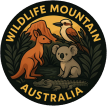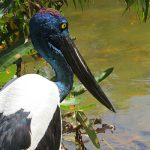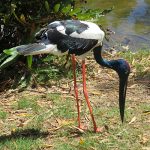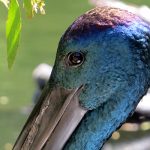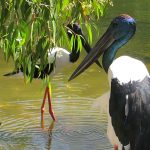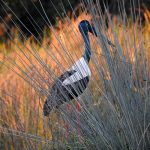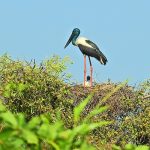BLACK-NECKED STORK ( JABIRU)
(Ephippiorhynchus asiaticus)
Australia’s Majestic Wetland Sentinel
The Black-necked Stork, known scientifically as Ephippiorhynchus asiaticus, is a striking and charismatic bird found in the wetlands of Australia and parts of south and southeast Asia. Its towering presence and vivid plumage have not only inspired animal lovers and naturalists but have also carried significant cultural resonance for thousands of years.
This article explores the physical characteristics, habitat and distribution, diet, breeding behaviour, lifespan, conservation status, vocalisations, cultural importance, and fascinating facts about this unforgettable species.
What Does the Black-necked Stork Look Like?
The Black-necked Stork is one of Australia’s tallest and most visually arresting waterbirds.
- Size: Adult storks stand up to 1.3 metres tall, with a wingspan that can reach 2.3 metres.
- Plumage: As its name suggests, it features a glossy black neck and head, which shimmers with iridescent hues of green and purple when caught in sunlight. The breast and belly are bright white, creating a sharp contrast.
- Bill: It sports a long, straight, heavy bill—shiny black in colour—perfectly adapted for grasping slippery prey.
- Legs: The legs are long and a striking reddish-pink in adults, supporting the stork’s elegant stature as it wades through wetlands.
- Sexual Dimorphism: Females can be distinguished from males by their yellow irises, whereas males typically have brown eyes.
The bird’s upright gait and slow, deliberate movements lend an air of grace and authority to its presence in the landscape.
Where Is the Black-necked Stork Found?
In Australia, the Black-necked Stork primarily inhabits the tropical and subtropical regions to the north and east.
- Geographic Range: Northeastern parts of Queensland and the Top End of the Northern Territory are strongholds, with smaller populations in northern Western Australia and occasional appearances in New South Wales.
- Preferred Habitat: They are closely associated with wetlands—freshwater lagoons, floodplains, billabongs, swamps, and coastal mudflats. These areas provide both the shallow water conditions and abundant food that storks need to thrive.
Outside Australia, the species ranges across the Indian subcontinent, southeast Asia, and Papua New Guinea.
What Does the Black-necked Stork Eat?
The Black-necked Stork is an opportunistic carnivore, with its diet finely tuned to wetland habitats.
- Main Prey: Fish, frogs, large insects, crustaceans, and reptiles—including freshwater turtles and even small snakes—are all on the menu.
- Hunting Technique: Characteristically, the stork moves with patience through shallow water, using its sharp eyesight to spot prey before striking rapidly with its bill. The movement is purposeful and often breathtaking in its efficiency.
This varied diet helps the stork adapt to seasonal changes in food availability.
Breeding Habits
The courtship and breeding behaviour of the Black-necked Stork is a spectacle of nature.
Nesting
- Nest Site: Nests are typically built in large trees overlooking water, often reused and refurbished year after year.
- Nest Structure: The structure is a substantial platform made of sticks, lined with softer plant material.
Reproduction
- Clutch Size: Generally, 2 to 4 eggs are laid.
- Incubation: Both parents share incubation duties for about 35–40 days.
- Chick Rearing: Both sexes contribute to feeding and protecting the chicks, who fledge after approximately 70–90 days.
Courtship Displays
During breeding season, pairs engage in synchronised dance-like displays, head-bobbing, and bill-clattering—a visual and auditory celebration of partnership.
Longevity
- Wild Lifespan: Black-necked Storks can live up to 20–30 years in the wild, though survival rates for chicks to adulthood can vary due to predation and environmental factors.
- Captive Records: Some individuals in protected environments have lived even longer, benefiting from consistent food and lack of predators.
Conservation Status
According to the International Union for Conservation of Nature (IUCN), the Black-necked Stork’s conservation status varies across its range:
- Global Status: Listed as Least Concern globally, but regional populations face unique threats.
- Australian Status: Considered endangered or vulnerable in certain states such as New South Wales due to habitat loss, alteration of water regimes, and disturbances during breeding season.
- Threats: Major threats include wetland drainage, land clearing for agriculture, pollution, and human disturbance.
Conserving these birds means safeguarding rich, biodiverse wetland ecosystems upon which many species—including humans—depend.
Sounds and Vocalisations
Despite its size, the Black-necked Stork is generally a silent bird. However, during breeding and territorial displays, it produces:
- Bill-Clattering: A sharp clattering or clicking sound made by rapidly snapping the bill, often used during courtship or as a warning signal.
- Hissing & Grunting: Occasionally, soft hissing or low-frequency grunting noises may be heard during nest defence or interactions with chicks.
At dawn and dusk, these sounds carry over the water, threading through the symphony of Australia’s wetland life.
Aboriginal Significance
The Black-necked Stork has a long-standing cultural presence among various Aboriginal communities.
- Totemic Status: In some Indigenous cultures, the bird is a totem representing wetland health, seasonal change, and the wisdom of elders.
- Art & Story: Ancient rock art and contemporary Indigenous paintings often feature the stork, symbolising the interconnectedness of people, land, and water.
These cultural narratives emphasise respect for the bird and the vital wetlands it inhabits.
Fascinating Facts
- Unique to Australia: The Black-necked Stork is Australia’s only resident stork species.
- Flight: When airborne, its outstretched neck and trailing legs form a distinctive silhouette against the sky.
- Bill as a Tool: The stork has been observed using its bill to skillfully manipulate, flip, and even crush harder prey items.
- Breeding Pair Bonds: Mated pairs are largely monogamous and may remain together for many years, sometimes returning to the same nest for successive breeding seasons.
- Ecosystem Indicator: As a top predator in wetland systems, the stork’s presence is a strong indicator of ecosystem health.
The Black-necked Stork stands as a living emblem of Australia’s wetlands—resilient, noble, and intricately tied to both the landscape and local cultural identity. Its survival is inseparable from the future of our rivers and floodplains, reminding us of the delicate balance that sustains all life. Observing a Black-necked Stork in the wild is to witness a timeless moment, where the ancient rhythms of nature and the vibrant chorus of Australian life come together.
By understanding, respecting, and working to protect this remarkable species and its habitats, we help ensure that the spirit and song of the Black-necked Stork will continue to inspire generations to come.
References
- Australian Bird Guide, Menkhorst, P. et al. (2017)
- BirdLife Australia Species Profile: Black-necked Stork
- IUCN Red List Entry: Ephippiorhynchus asiaticus
- Beruldsen, G. (2003). Australian Birds: their Nests and Eggs.
- Atlas of Living Australia: Ephippiorhynchus asiaticus profile
